Study on the Life Cycle Assessment of Automotive Power Batteries Considering Multi-Cycle Utilization
Abstract
:1. Introduction
2. Life Cycle Assessment Model for Power Batteries
2.1. Evaluation Object and System Boundary
2.2. Mathematical Evaluation Model
2.2.1. Mathematical Evaluation Model for Resource Depletion
2.2.2. Mathematical Evaluation Model for Environmental Emissions
2.2.3. The Mathematical Evaluation Model for the Secondary Utilization of Power Batteries
2.3. The GaBi Evaluation Model
2.3.1. The Lithium Iron Phosphate (LFP) Battery Evaluation Model
2.3.2. The Evaluation Model for Ternary Lithium-Ion Batteries
3. Evaluation Results Analysis
3.1. Resource Depletion Results Analysis
3.2. Analysis of Environmental Impact Results
4. Scenario Analysis and Discussion
4.1. Scenario Analysis of Different Power Battery Recycling Processes
4.1.1. Recycling Process Scenarios
4.1.2. Analysis of Evaluation Results
4.2. Benefit Analysis of Decommissioned Power Battery Trapezoidal Utilization
4.2.1. Laddering of Utilization Scenarios
4.2.2. Analysis of Evaluation Results
4.3. Sensitivity Analysis Considering the Individual Cell Conversion Rate
5. Conclusions
Author Contributions
Funding
Data Availability Statement
Conflicts of Interest
References
- Hao, Z.; Ma, Y.; Wang, P.; Luo, G.; Chen, Y. A Review of Axial-Flux Permanent-Magnet Motors: Topological Structures, Design, Optimization and Control Techniques. Machines 2022, 10, 1178. [Google Scholar] [CrossRef]
- Xiuqi, L. China Association of Automobile Manufacturers: China’s new energy vehicle production and sales have ranked first globally for 8 consecutive years. China Energy News, 16 January 2023. [Google Scholar]
- Temporelli, A.; Carvalho, M.L.; Girardi, P. Life cycle assessment of electric vehicle batteries: An overview of recent literature. Energies 2020, 13, 2864. [Google Scholar] [CrossRef]
- Sousa, N.; Coutinho-Rodrigues, J. Quest for sustainability: Life-cycle emissions assessment of electric vehicles considering newer Li-Ion batteries. Sustainability 2019, 11, 2366. [Google Scholar]
- Zackrisson, M.; Avellan, L.; Orlenius, J. Life cycle assessment of lithium-ion batteries for plug-in hybrid electric vehicles—Critical issues. J. Clean. Prod. 2010, 18, 1519–1529. [Google Scholar] [CrossRef]
- Cusenza, M.A.; Bobba, S.; Ardente, F.; Cellura, M.; Di Persio, F. Energy and environmental assessment of a traction lithium-ion battery pack for plug-in hybrid electric vehicles. J. Clean. Prod. 2019, 215, 634–649. [Google Scholar] [CrossRef] [PubMed]
- Kantor, I.; Fowler, M.W.; Hajimiragha, A.; Elkamel, A. Air quality and environmental impacts of alternative vehicle technologies in Ontario, Canada. Int. J. Hydrogen Energy 2010, 35, 5145–5153. [Google Scholar] [CrossRef]
- Ahmadi, P.; Raeesi, M.; Changizian, S.; Teimouri, A.; Khoshnevisan, A. Life cycle assessment of diesel, diesel-electric and hydrogen fuel cell transit buses with fuel cell degradation and battery aging using machine learning techniques. Energy 2022, 259, 125003. [Google Scholar] [CrossRef]
- Majeau-Bettez, G.; Hawkins, T.R.; Stromman, A.H. Life cycle environmental assessment of lithium-ion and nickel metal hydride batteries for plug-in hybrid and battery electric vehicles. Environ. Sci. Technol. 2011, 45, 4548–4554. [Google Scholar] [CrossRef] [PubMed]
- Oliveira, L.; Messagie, M.; Rangaraju, S.; Sanfelix, J.; Rivas, M.H.; Van Mierlo, J. Key issues of lithium-ion batteries—From resource depletion to environmental performance indicators. J. Clean. Prod. 2016, 108, 354–362. [Google Scholar] [CrossRef]
- Marques, P.; Garcia, R.; Kulay, L.; Freire, F. Comparative life cycle assessment of lithium-ion batteries for electric vehicles addressing capacity fade. J. Clean. Prod. 2019, 229, 787–794. [Google Scholar] [CrossRef]
- Ambrose, H.; Kendall, A. Understanding the Future of Lithium: Part 2, Temporally and Spatially ResolvedLife-Cycle Assessment Modeling. J. Ind. Ecol. 2020, 24, 90–100. [Google Scholar] [CrossRef]
- Ellingsen, L.A.-W.; Majeau-Bettez, G.; Singh, B.; Srivastava, A.K.; Valøen, L.O.; Strømman, A.H. Life Cycle Assessment of a Lithium-Ion Battery Vehicle Pack. J. Ind. Ecol. 2014, 18, 113–124. [Google Scholar] [CrossRef]
- Dai, Q.; Kelly, J.C.; Gaines, L.; Wang, M. Life Cycle Analysis of Lithium-Ion Batteries for Automotive Applications. Batteries 2019, 5, 48. [Google Scholar] [CrossRef]
- Petersac, J.F.; Weil, M. Providing a Common Base for Life Cycle Assessments of Li-Ion Batteries. J. Clean. Prod. 2018, 171, 704–713. [Google Scholar] [CrossRef]
- Sun, X.; Luo, X.; Zhang, Z.; Meng, F.; Yang, J. Life CycleAssessment of Lithium Nickel Cobalt Manganese Oxide (NCM) Batteries for Electric Passenger Vehicles. J. Clean. Prod. 2020, 273, 123006. [Google Scholar] [CrossRef]
- Accardo, A.; Dotelli, G.; Musa, M.L.; Spessa, E. Life Cycle Assessment of an NMC Battery for Application toElectric Light-Duty Commercial Vehicles and Comparison with a Sodium-Nickel-Chloride Battery. Appl. Sci. 2021, 11, 1160. [Google Scholar] [CrossRef]
- Ahmadi, L.; Young, S.B.; Fowler, M.; Fraser, R.A.; Achachlouei, M.A. A Cascaded Life Cycle: Reuse of Electric Vehicle Lithium-Ion Battery Packs in Energy Storage Systems. Int. J. Life Cycle Assess. 2017, 22, 111–124. [Google Scholar] [CrossRef]
- Chen, M.; Ma, X.; Chen, B.; Arsenault, R.; Karlson, P.; Simon, N.; Wang, Y. Recycling End-of-Life Electric Vehicle Lithium-Ion Batteries. Joule 2019, 3, 2622–2646. [Google Scholar] [CrossRef]
- Jia, Z.; Gao, F.; Du, S.; Sun, B. Life Cycle of Different Application Scenarios of Assessment Lithium-Iron Phosphate Batteries. China Env.-Ment. Sci. 2022, 42, 1975–1984. (In Chinese) [Google Scholar]
- Ioakimidis, C.S.; Murillo-Marrodán, A.; Bagheri, A.; Thomas, D.; Genikomsakis, K.N. Life Cycle Assessment of a Lithium Iron Phosphate (LFP) Electric Vehicle Battery in Second Life Application Scenarios. Sustainability 2019, 11, 2527. [Google Scholar] [CrossRef]
- Lingyun, Z.; Ming, C. Development of a Two-Stage Pyrolysis Process for the End-of-Life Nickel Cobalt Manganese Lithium Battery Recycling from Electric Vehicles. Sustainability 2020, 12, 9164. [Google Scholar]
- Liu, S. Comparative Study on Life Cycle Assessment of Li-Ion Power Battery and Pure Electric Vehicle. Master’s Thesis, Chang’an University, Xi’an, China, 2021. [Google Scholar]
- Sanfélix, J.; Messagie, M.; Omar, N.; Van Mierlo, J.; Hennige, V. Environmental performance of advanced hybrid energy storage systems for electric vehicle applications. Appl. Energy 2015, 137, 925–930. [Google Scholar] [CrossRef]
- Richa, K.; Babbitt, C.W.; Gaustad, G.; Wang, X. A future perspective on lithium-ion battery waste flows from electric vehicles. Resour. Conserv. Recycl. 2014, 83, 63–76. [Google Scholar] [CrossRef]
- Mahmud, M.A.P.; Huda, N.; Farjana, S.H.; Lang, C. Comparative life cycle environmental impact analysis of lithium-ion (LiIo) and nickel-metal hydride (NiMH) batteries. Batteries 2019, 5, 22. [Google Scholar] [CrossRef]
- Blömeke, S.; Scheller, C.; Cerdas, F.; Thies, C.; Hachenberger, R.; Gonter, M.; Herrmann, C.; Spengler, T.S. Material and energy flow analysis for environmental and economic impact assessment of industrial recycling routes for lithium-ion traction batteries. J. Clean. Prod. 2022, 377, 134344. [Google Scholar] [CrossRef]
- Casals, L.C.; García, B.A.; Aguesse, F.; Iturrondobeitia, A. Second life of electric vehicle batteries: Relation between materials degradation and environmental impact. Int. J. Life Cycle Assess. 2018, 22, 82–93. [Google Scholar] [CrossRef]
- Heymans, C.; Walker, S.B.; Young, S.B.; Fowler, M. Economic analysis of second use electric vehicle batteries for residential energy storage and load-levelling. Energy Policy 2014, 71, 22–30. [Google Scholar] [CrossRef]
- Ahmadi, L.; Fowler, M.; Young, S.B.; Fraser, R.A.; Gaffney, B.; Walker, S.B. Energy efficiency of Li-ion battery packs re-used in stationary power applications. Sustain. Energy Technol. Assess. 2014, 8, 9–17. [Google Scholar] [CrossRef]
- Faria, R.; Marques, P.; Garcia, R.; Moura, P.; Freire, F.; Delgado, J.; de Almeida, A.T. Primary and secondary use of electric mobility batteries from a life cycle perspective. J. Power Sources 2014, 262, 169–177. [Google Scholar] [CrossRef]
- Chen, Y.; Lan, L.; Hao, Z.; Fu, P. Cradle-grave energy consumption, greenhouse gas and acidification emissions in current and future fuel cell vehicles: Study based on five hydrogen production methods in China. Energy Rep. 2022, 8, 7931–7944. [Google Scholar] [CrossRef]
- Chen, Y.; Lan, L.; Du, Y.; Wang, T.; Xu, H. Evaluation of environmental benefits and carbon reduction economy of EREV/BEV/ICEV based on life cycle assessment theory. Acta Sci. Circumstantiae 2023, 43, 516–527. [Google Scholar]
- Chen, Y.; Lan, L.; Hao, Z.; Fu, P. Life cycle assessment and key parameters comparison of hydrogen fuel cell vehicle power system. Environ. Sci. 2022, 43, 4402–4412. [Google Scholar]
- Fu, P.; Lan, L.B.; Chen, Y.; Hao, Z.; Xing, Y.X.; Cai, X.; Zhang, C.M.; Chen, Y.S. Life cycle prediction assessment of energy saving and new energy vehicles for 2035. Environ. Sci. 2023, 44, 2365–2374. [Google Scholar]
- Zhang, S.; Zhang, C.; Cai, X.; Lan, L.; Zhang, J. Life cycle prediction assessment of hydrogen fuel cells and diesel heavy-duty commercial vehicles for 2035. Res. Environ. Sci. 2023, 1–17. [Google Scholar] [CrossRef]
- Hao, H.; Mu, Z.; Jiang, S.; Liu, Z.; Zhao, F. GHG emissions from the production of lithium-ion batteries for electric vehicles in China. Sustainability 2017, 9, 504. [Google Scholar] [CrossRef]
- Ma, J. Life Cycle Assessment on a specific BEV with Different Power-Batteries. Master’s Thesis, Chang’an University, Xi’an, China, 2021. [Google Scholar]
- Liu, J. Life Cycle Assessment of Hydrogen Fuel Cell Vehicle. Master’s Thesis, Chang’an University, Xi’an, China, 2021. [Google Scholar]
- Chen, H.; Zhang, T.; Gao, Q.; Han, Z.; Jin, Y.; Li, L.; Yang, K.; Xu, Y.; Liu, X.; Xu, X.; et al. Assessment and management of health status in full life cycle of echelon utilization for retired power lithium batteries. J. Clean. Prod. 2022, 379, 134583. [Google Scholar] [CrossRef]
- Sommerville, R.; Zhu, P.; Rajaeifar, M.A.; Heidrich, O.; Goodship, V.; Kendrick, E. A qualitative assessment of lithium-ion battery recycling processes. Resour. Conserv. Recycl. 2021, 165, 105219. [Google Scholar] [CrossRef]
- Hua, Y.; Liu, X.; Zhou, S.; Huang, Y.; Ling, H.; Yang, S. Toward sustainable reuse of retired lithium-ion batteries from electric vehicles. Resour. Conserv. Recycl. 2021, 168, 105249. [Google Scholar] [CrossRef]
- Richa, K.; Babbitt, C.W.; Nenadic, N.G.; Gaustad, G. Environmental trade-offs across cascading lithium-ion battery life cycles. Int. J. Life Cycle Assess. 2017, 22, 66–81. [Google Scholar] [CrossRef]
- Feng, T.; Guo, W.; Li, Q.; Meng, Z.; Liang, W. Life cycle assessment of lithium nickel cobalt manganese oxide batteries and lithium iron phosphate batteries for electric vehicles in China. J. Energy Storage 2022, 52, 104767. [Google Scholar] [CrossRef]
- Quan, J.; Zhao, S.; Song, D.; Wang, T.; He, W.; Li, G. Comparative life cycle assessment of LFP and NCM batteries including the secondary use and different recycling technologies. Sci. Total Environ. 2022, 819, 153105. [Google Scholar] [CrossRef] [PubMed]
- Wang, Y.; Tang, B.; Shen, M.; Wu, Y.; Qu, S.; Hu, Y.; Feng, Y. Environmental impact assessment of second life and recycling for LiFePO4 power batteries in China. J. Environ. Manag. 2022, 314, 115083. [Google Scholar] [CrossRef] [PubMed]
- Koroma, M.S.; Costa, D.; Philippot, M.; Cardellini, G.; Hosen, S.; Coosemans, T.; Messagie, M. Life cycle assessment of battery electric vehicles: Implications of future electricity mix and different battery end-of-life management. Sci. Total. Environ. 2022, 831, 154859. [Google Scholar] [CrossRef] [PubMed]
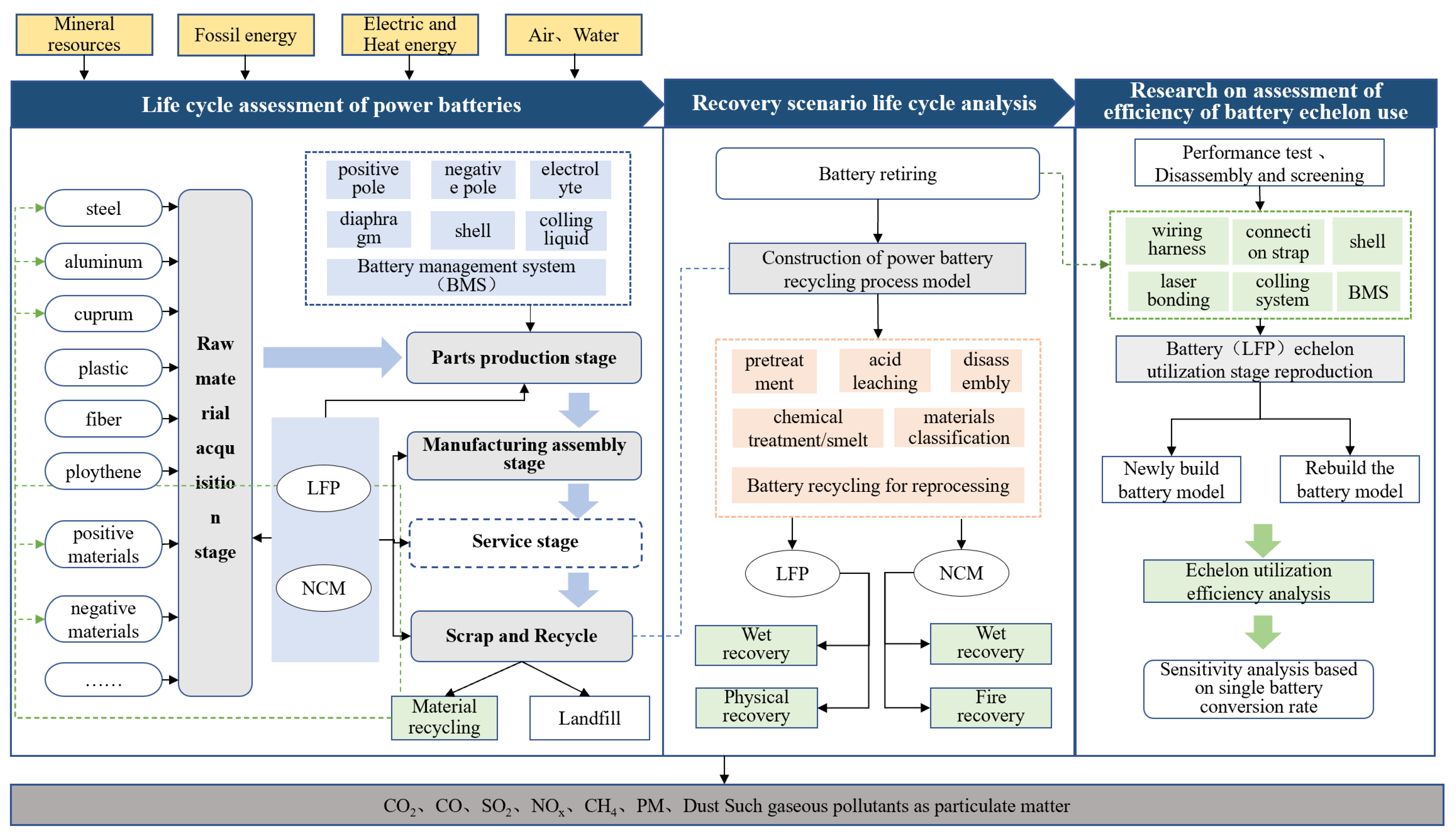
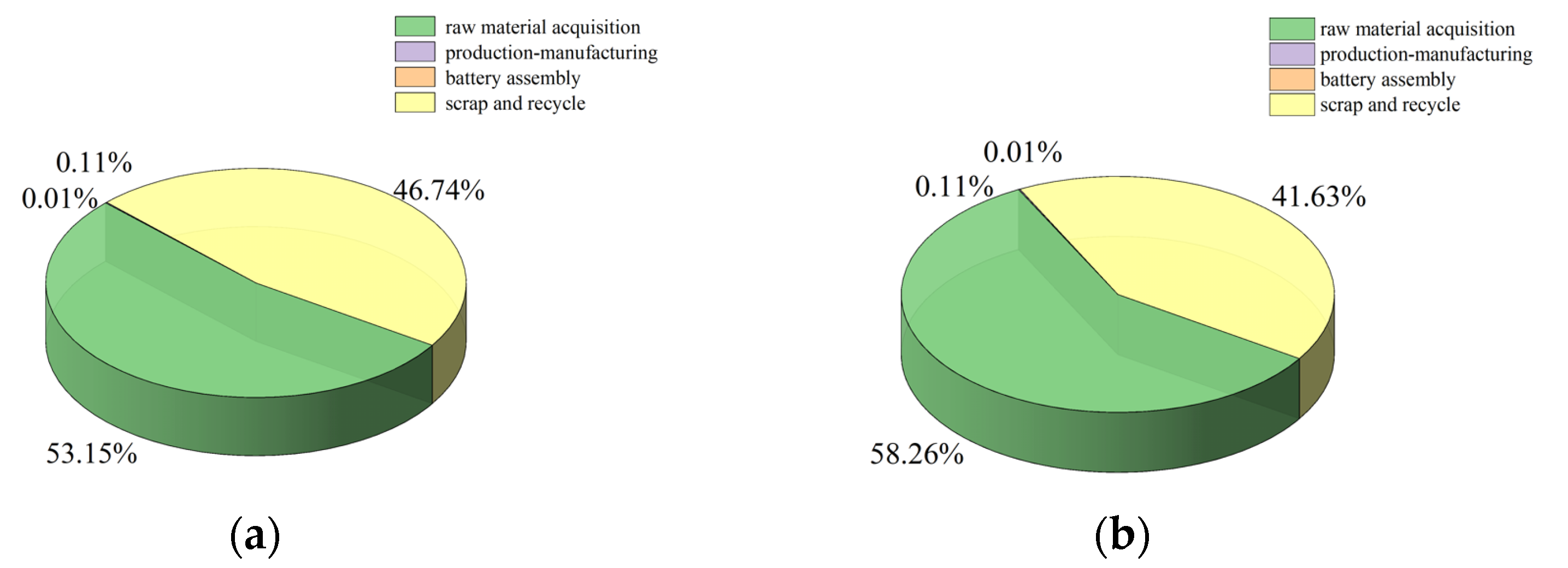
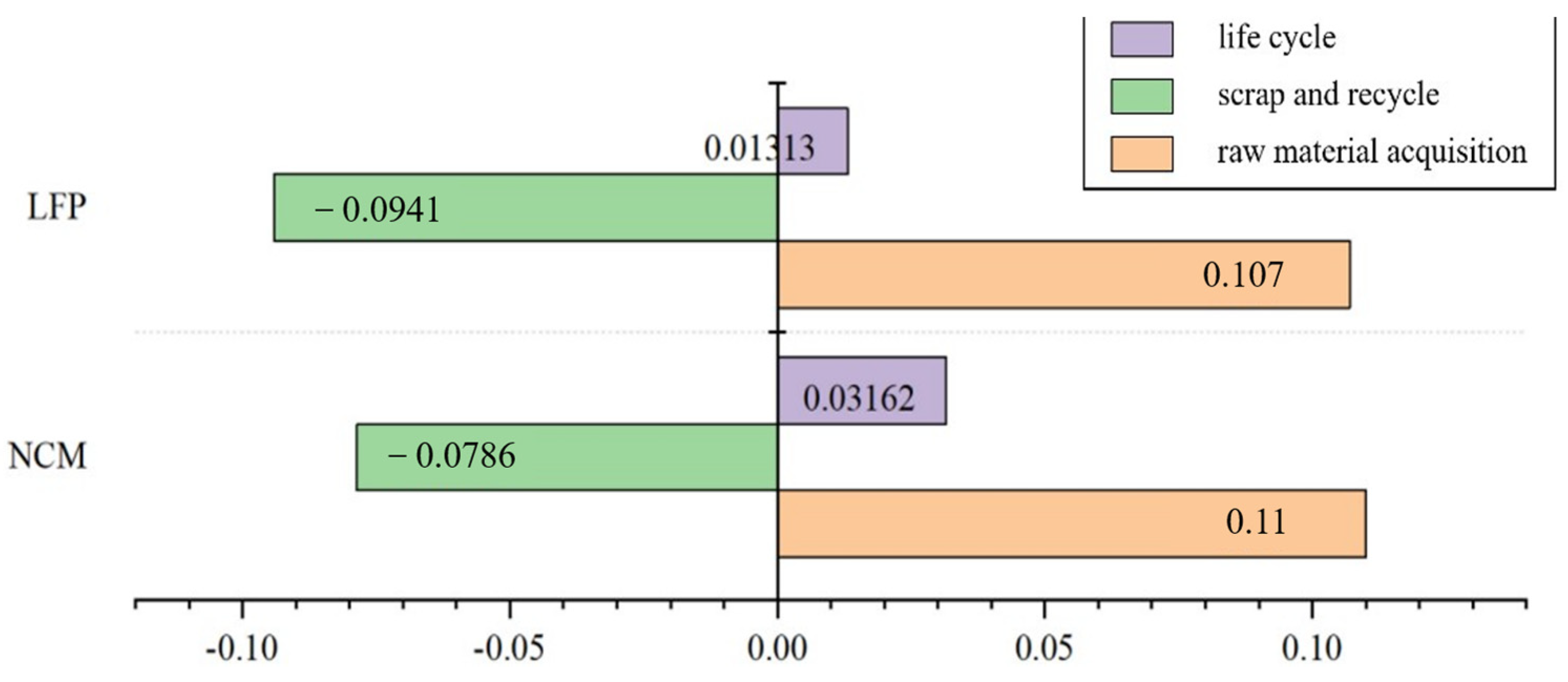

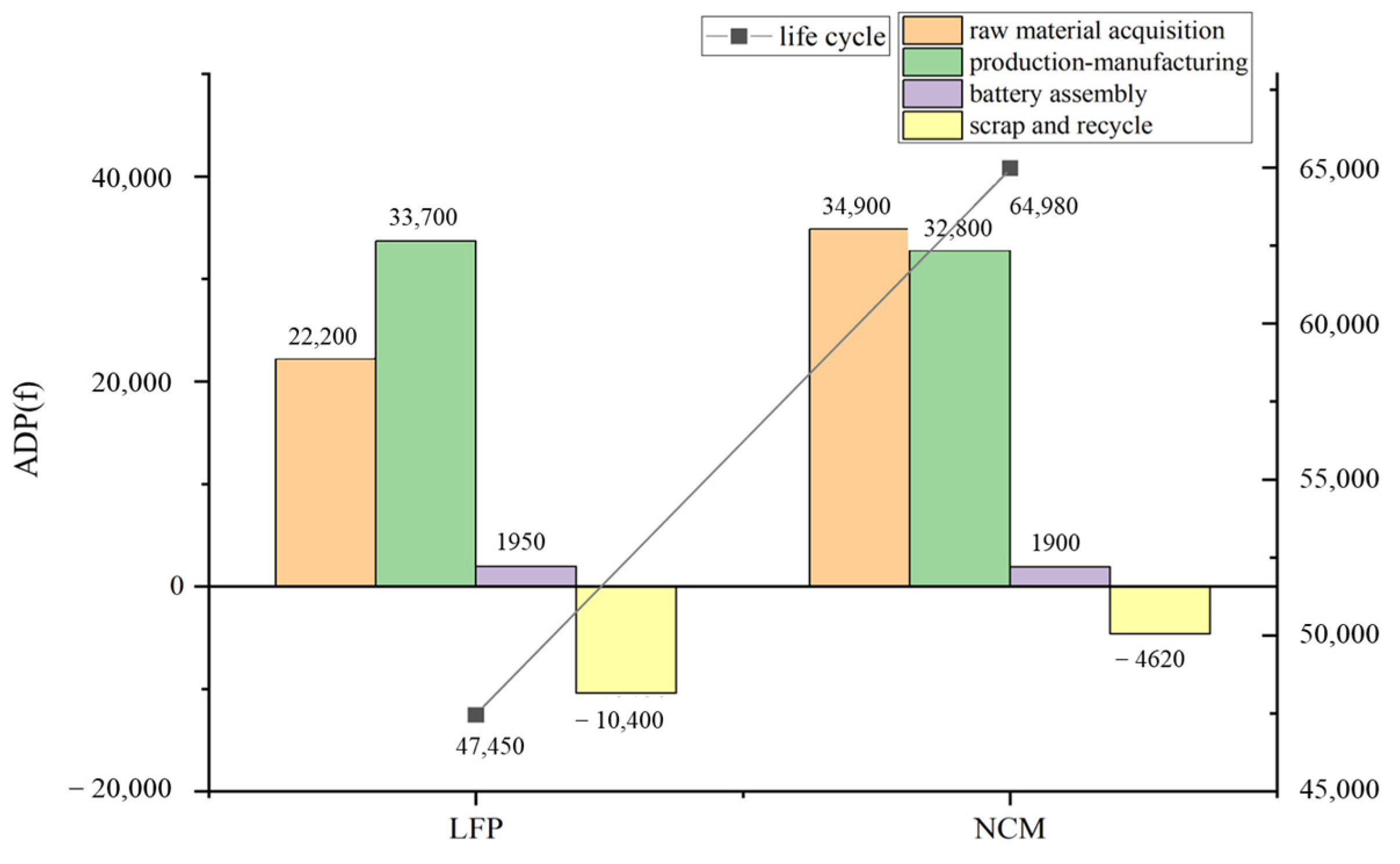
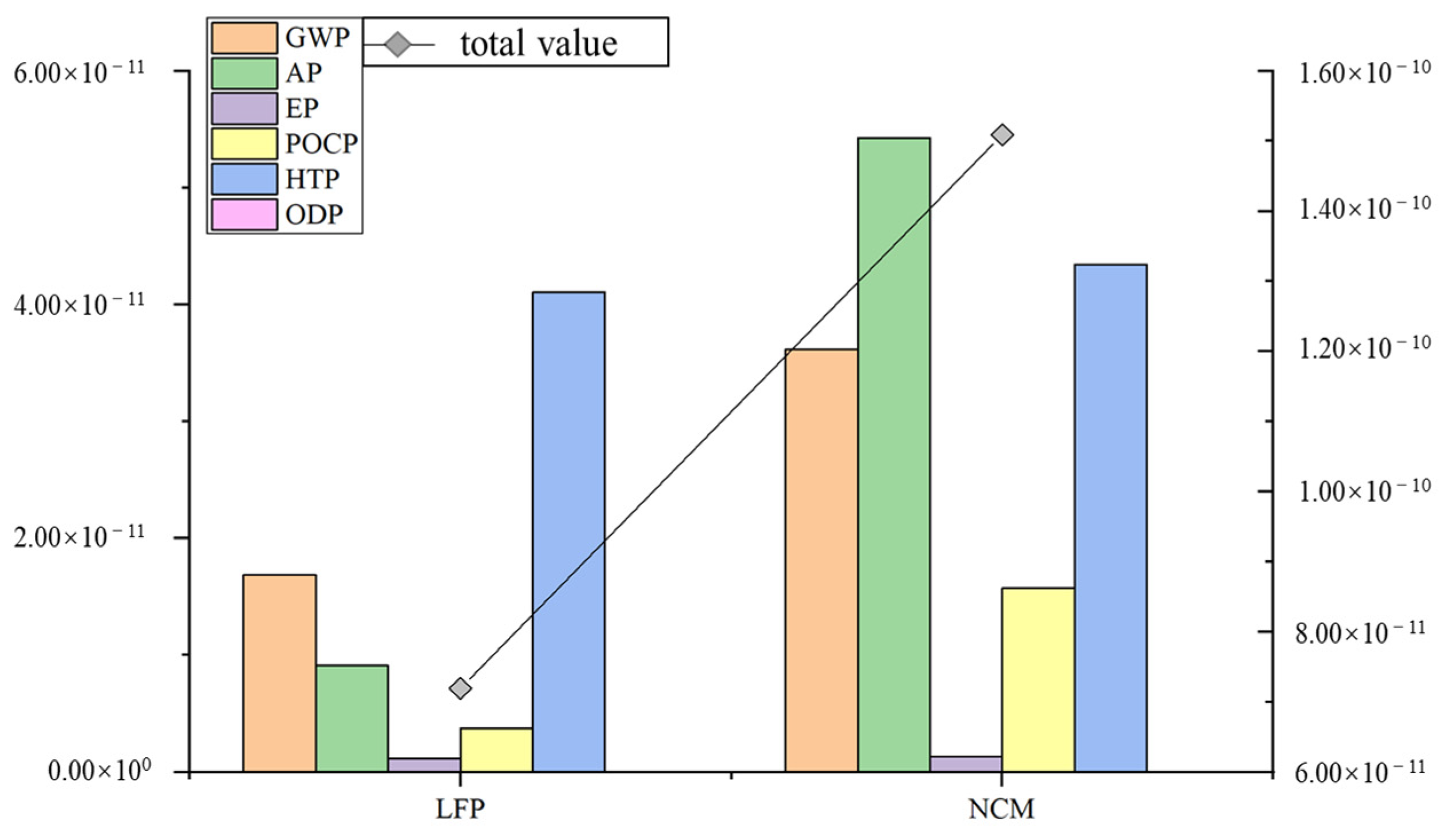
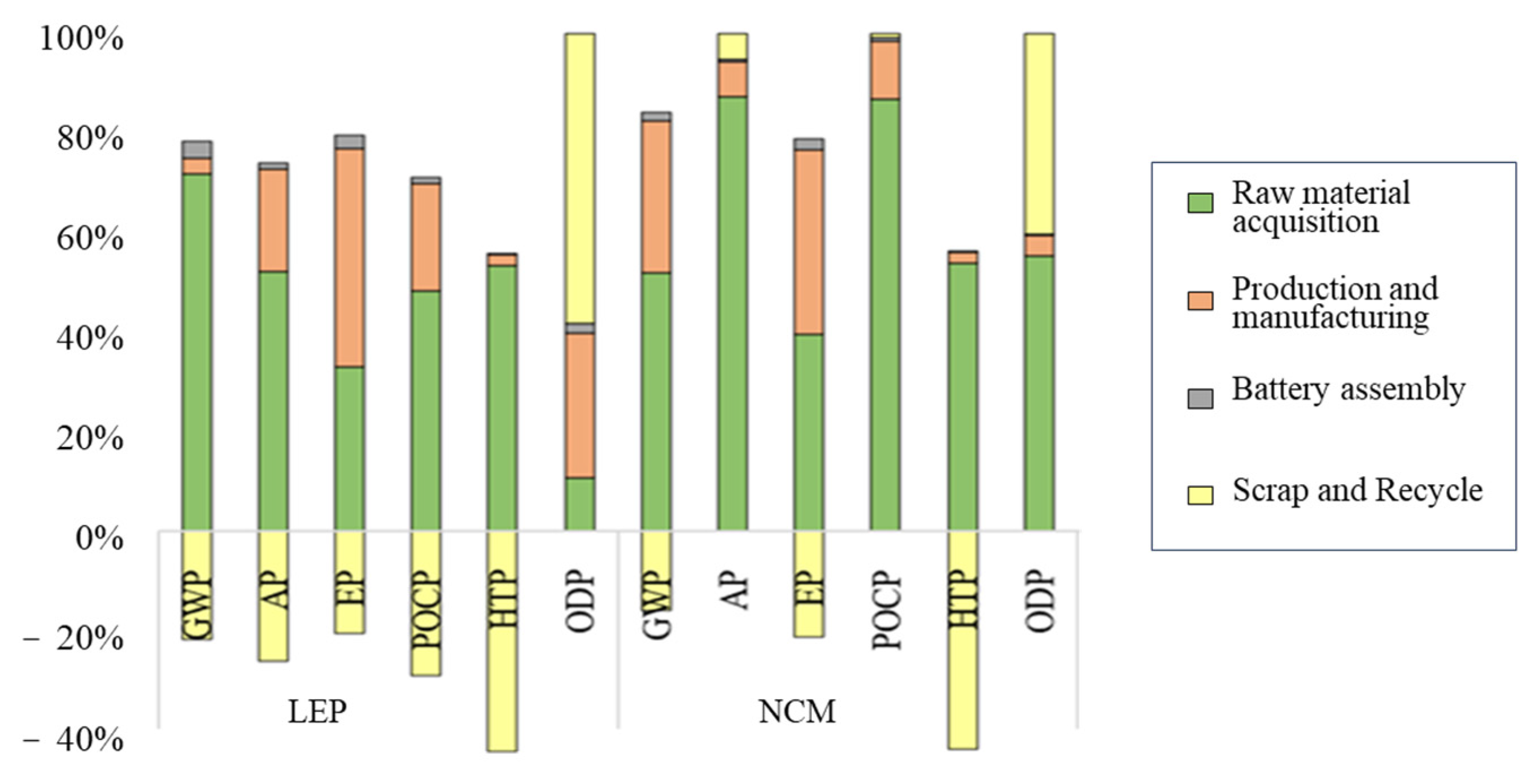
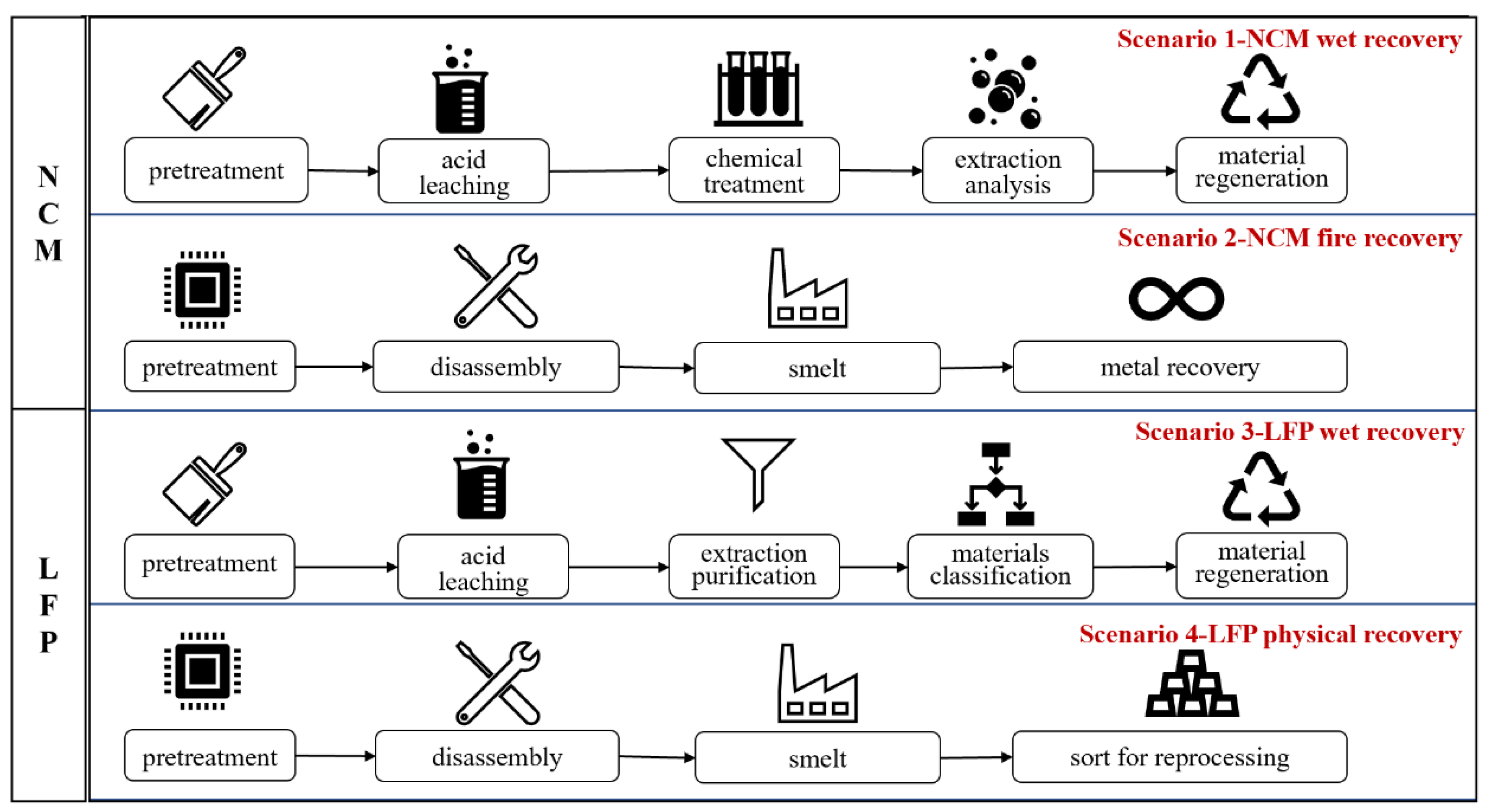


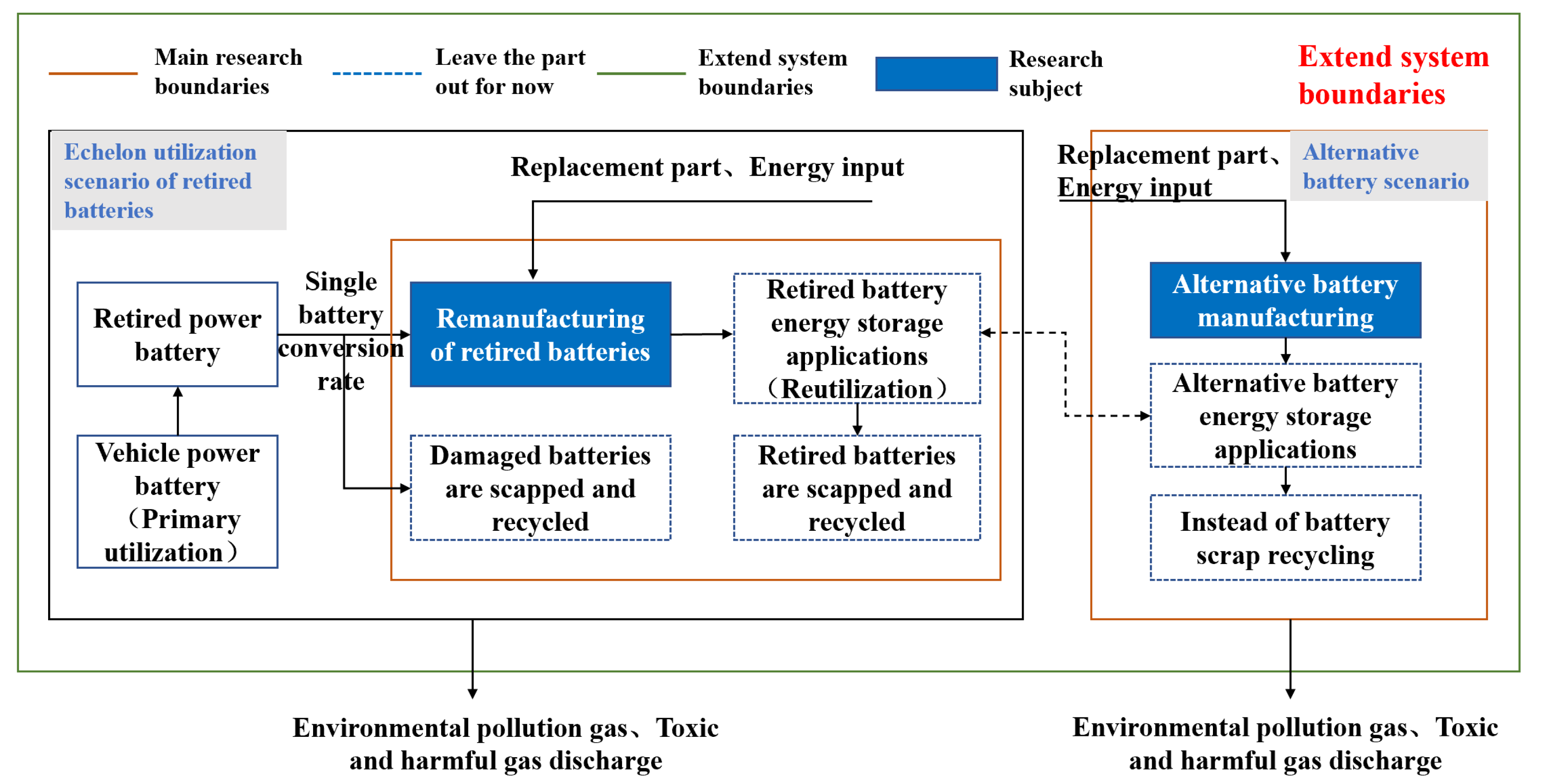
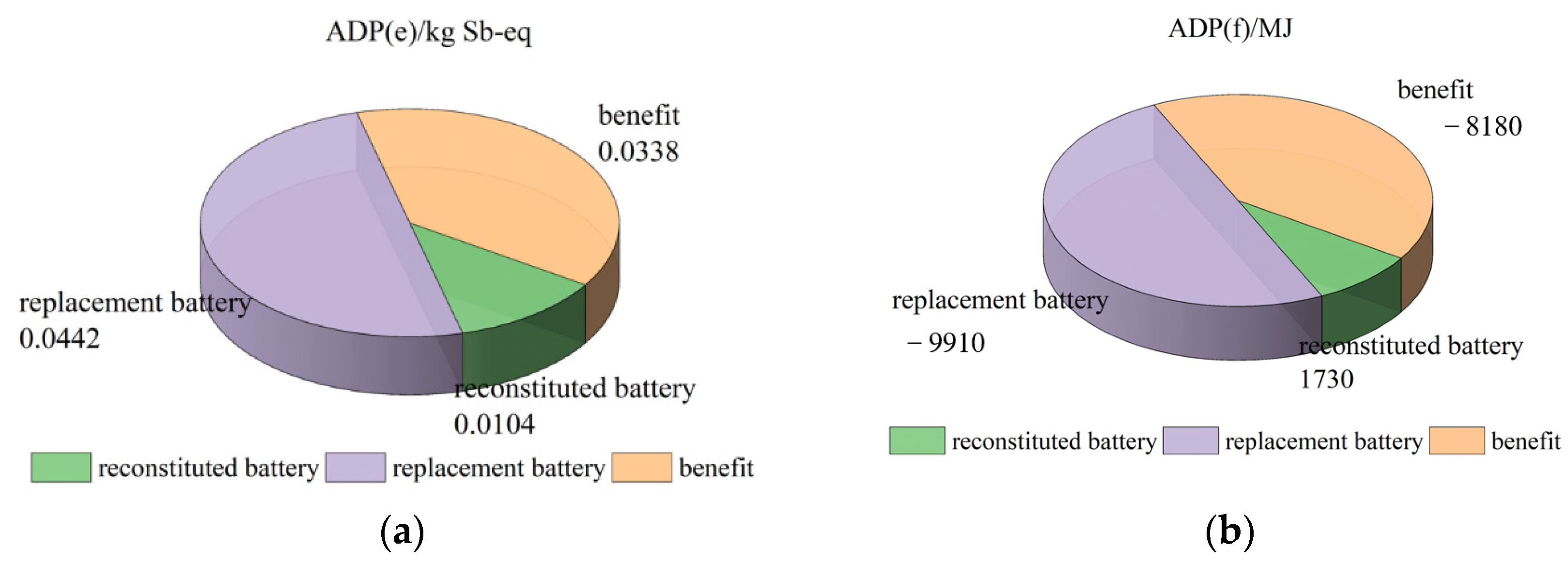
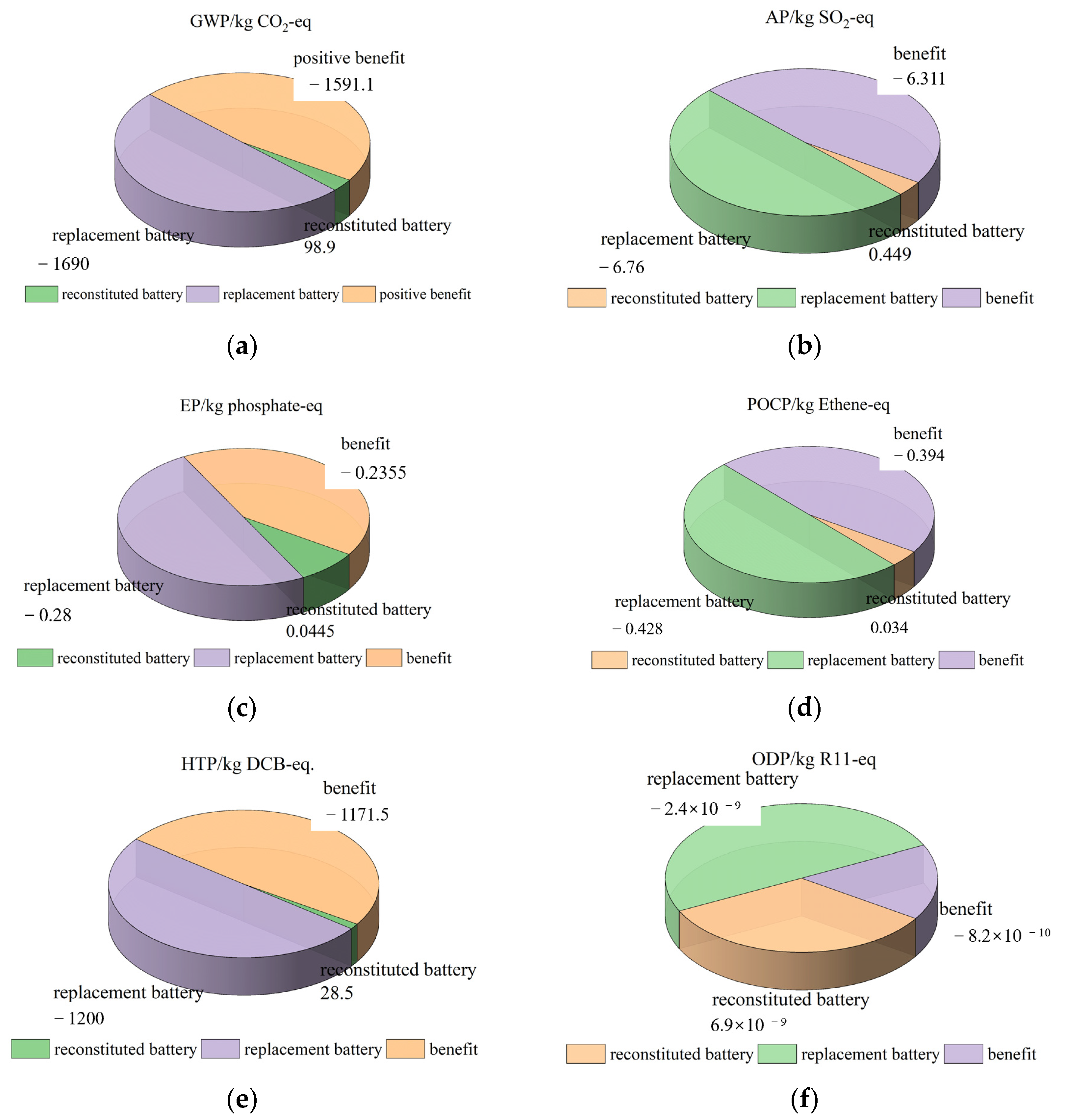
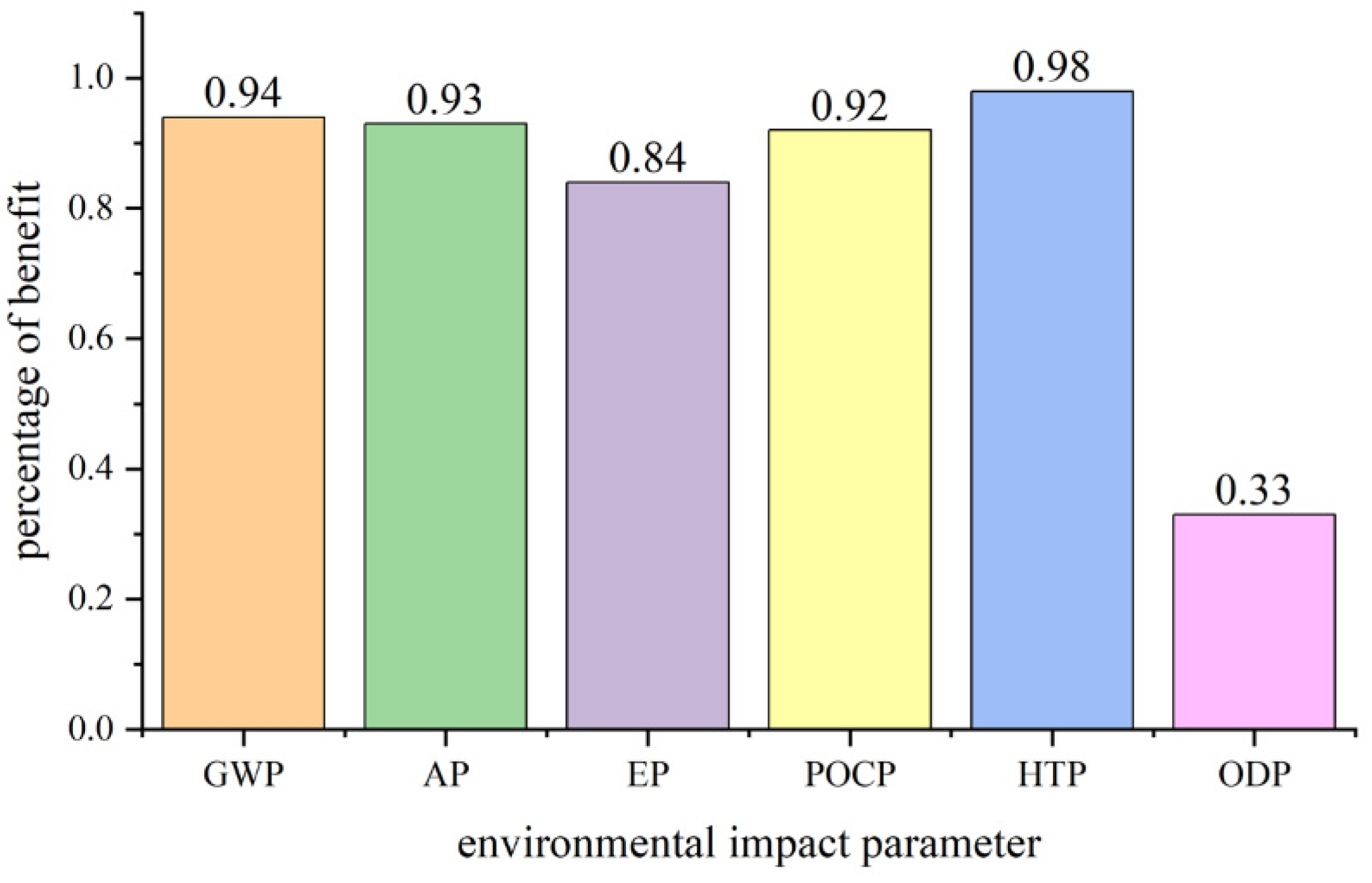

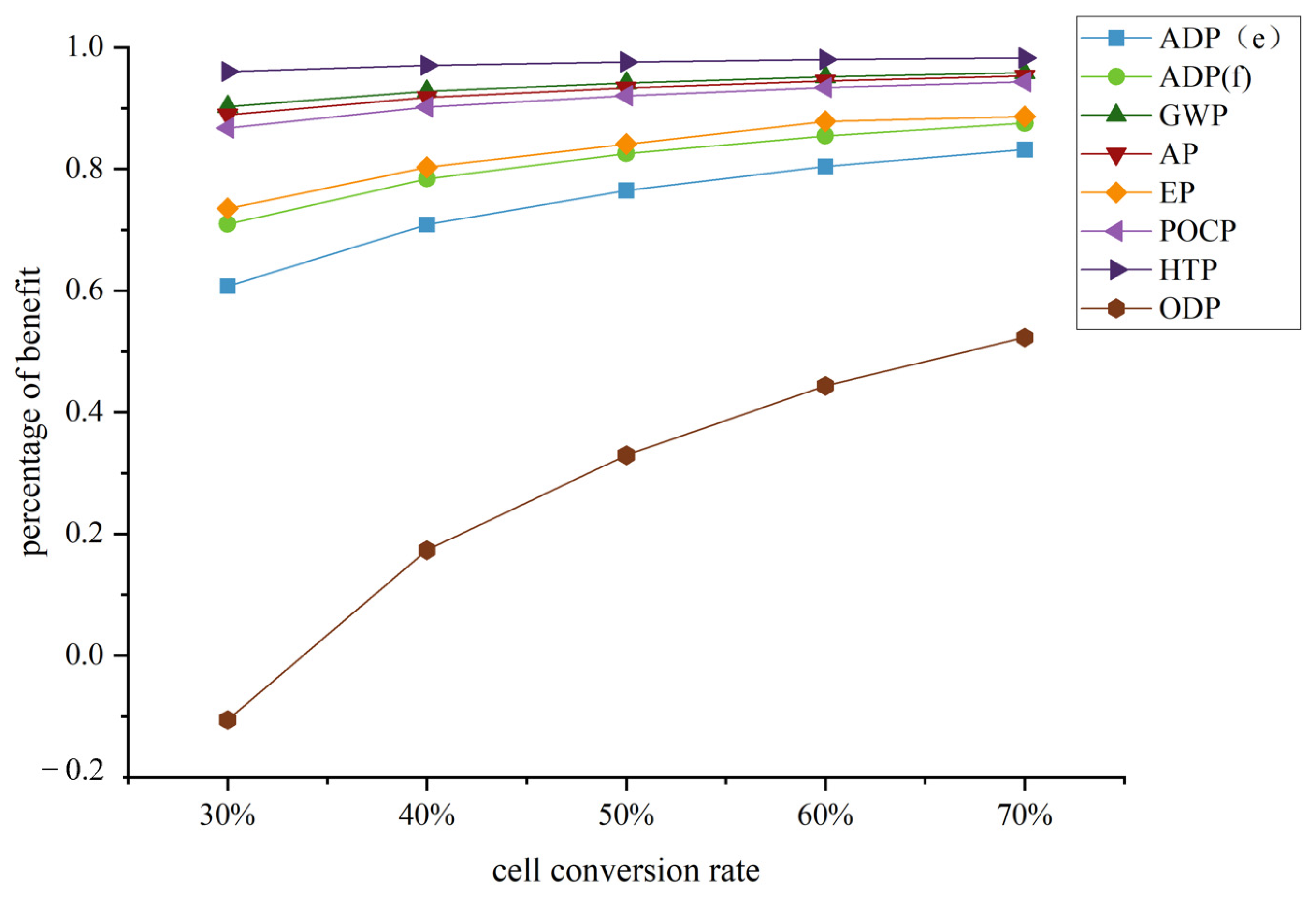
| NCM | LFP | |
|---|---|---|
| anode material | nickel–cobalt–manganese ternary materials | lithium iron phosphate materials |
| cathode material | plumbago | plumbago |
| energy density | around 170 Wh/kg | around 160 Wh/kg |
| cycle life | around 800 | around 2000 |
| costs | general | general |
| safety | mediocre | high |
| low temperature resistance | general | mediocre |
| high temperature resistance | general | higher |
| Type of Environmental Impact | Normalized Reference Value | Weights (Dimensionless) | Evaluation Calculation Model |
|---|---|---|---|
| GWP | 4.22 × 1013 kg CO2-eq. | 0.222488038 | |
| AP | 2.39 × 1011 kg SO2-eq. | 0.145933014 | |
| EP | 1.58 × 1011 kg Phosphate-eq. | 0.157894737 | |
| POCP | 3.68 × 1010 kg Ethene-eq. | 0.155502392 | |
| ODP | 2.27 × 108 kg CFC-eq. | 0.148325359 | |
| HTP | 2.58 × 1012 kg DCB-eq. | 0.169856459 |
| Battery Composition | Raw Materials | Mass/kg |
|---|---|---|
| anodal | lithium iron phosphate | 81.70 |
| aluminum | 68.01 | |
| Polyvinylidene chloride (PVDF) | 3.52 | |
| cathode | plumbago | 50.92 |
| copper | 41.54 | |
| PVDF | 3.52 | |
| electrolyte | lithium hexafluorophosphate | 9.05 |
| vinyl carbonate | 26.13 | |
| dimethyl acetate (CH3)2AsO2H | 26.13 | |
| clamshell | polypropylene | 4.34 |
| steel | 5.03 | |
| glass fiber | 1.01 | |
| distant | polypropylene | 6.37 |
| polyethylene | 1.01 | |
| coolant | Ethylene glycol (EU-28) | 3.35 |
| BMS | transistors | 1.68 |
| resistors | 1.68 |
| Input Material | Mass/kg | Modeling Mass/kg | Recycling of Metal Materials | Recovery Efficiency/% |
|---|---|---|---|---|
| common salt | 4.04 | 230.28 | copper | 90.00 |
| magnesium hydroxide | 0.59 | 33.35 | steel | 85.00 |
| caustic soda | 0.43 | 24.28 | foundry iron | 80.00 |
| thick water | 5.61 | 319.77 | aluminum | 85.00 |
| petroleum | 0.03 | 1.94 | lithium | 82.00 |
| Battery Composition | Raw Materials | Ratio/% | Mass/kg |
|---|---|---|---|
| anodal | lithium ternary | 28.20 | 91.93 |
| aluminum | 19.70 | 64.22 | |
| Polyvinylidene chloride (PVDF) | 1.20 | 3.91 | |
| cathode | plumbago | 18.30 | 59.66 |
| copper | 11.40 | 37.16 | |
| PVDF | 1.20 | 3.91 | |
| electrolyte | lithium hexafluorophosphate | 1.90 | 6.19 |
| vinyl carbonate | 5.40 | 17.60 | |
| dimethyl acetate (CH3)2AsO2H | 5.40 | 17.60 | |
| clamshell | polypropylene | 1.30 | 4.24 |
| steel | 1.50 | 4.89 | |
| glass fiber | 0.30 | 0.99 | |
| distant | polypropylene | 1.90 | 6.19 |
| polyethylene | 0.30 | 0.99 | |
| coolant | Ethylene glycol (EU-28) | 1.00 | 3.26 |
| BMS | transistors | 0.50 | 1.63 |
| resistors | 0.50 | 1.63 |
| Material Type | Unit | Number of Models |
|---|---|---|
| hydrogen peroxide (H2O2) | kg | 10.2 |
| sulfuric acid | kg | 19.7 |
| sodium hypochlorite | kg | 0.433 |
| pig iron | kg | 0.038 |
| calcium oxide | kg | 0.417 |
| hydrochloric acid | kg | 1.680 |
| 30% Liquid Soda Ash | kg | 20 |
| natural gas | Nm3 | 0.094 |
| electricity | kWh | 8.420 |
| Raw Material Acquisition | Manufacturing | Battery Assembly | End-of-Life Recycling | ||
|---|---|---|---|---|---|
| LFP | ADP(e) | 1.34 × 10−1 | 2.12 × 10−4 | 1.33 × 10−5 | −9.41 × 10−2 |
| ADP(f) | 2.22 × 104 | 3.37 × 104 | 1.95 × 103 | −1.04 × 104 | |
| NCM | ADP(e) | 1.10 × 10−1 | 2.06 × 10−4 | 1.29 × 10−5 | 4.21 × 10−2 |
| ADP(f) | 3.49 × 104 | 3.28 × 104 | 1.90 × 103 | 2.01 × 104 |
| Raw Material Acquisition | Manufacturing | Battery Assembly | End-of-Life Recycling | Life Cycle | ||
|---|---|---|---|---|---|---|
| LFP | GWP | 2.14 × 1011 | 9.81 × 10−13 | 9.81 × 10−13 | −6.48 × 10−12 | 1.69 × 10−11 |
| AP | 1.00 × 10−11 | 3.90 × 10−12 | 2.43 × 10−13 | −4.92 × 10−12 | 9.23 × 10−12 | |
| EP | 6.09 × 10−13 | 8.54 × 10−13 | 5.32 × 10−14 | −4.00 × 10−13 | 1.12 × 10−12 | |
| POCP | 4.23 × 10−12 | 1.89 × 10−12 | 1.14 × 10−13 | −2.56 × 10−12 | 3.67 × 10−12 | |
| HTP | 8.36 × 10−11 | 8.30 × 10−12 | 5.15 × 10−13 | −6.65 × 10−11 | 2.59 × 10−11 | |
| ODP | 1.18 × 10−18 | 1.04 × 10−17 | 6.60 × 10−19 | 2.08 × 10−17 | 3.30 × 10−17 | |
| NCM | GWP | 2.75 × 10−11 | 1.61 × 10−11 | 9.54 × 10−13 | −8.38 × 10−12 | 3.62 × 10−11 |
| AP | 4.74 × 10−11 | 3.79 × 10−12 | 2.37 × 10−13 | 2.87 × 10−12 | 5.43 × 10−11 | |
| EP | 8.91 × 10−13 | 8.31 × 10−13 | 5.18 × 10−14 | 2.81 × 10−13 | 2.06 × 10−12 | |
| POCP | 1.36 × 10−11 | 1.84 × 10−12 | 1.11 × 10−13 | 1.20 × 10−13 | 1.57 × 10−11 | |
| HTP | 1.38 × 10−10 | 8.03 × 10−12 | 5.02 × 10−13 | −8.49 × 10−11 | 6.19 × 10−11 | |
| ODP | 1.39 × 10−16 | 1.01 × 10−17 | 6.41 × 10−19 | 1.01 × 10−16 | 2.51 × 10−16 |
| Name | Unit | Number |
|---|---|---|
| BMS | kg | 3.00 |
| coolant | kg | 3.00 |
| clamshell | kg | 5.00 |
| plastic shell | kg | 15.03 |
| connection piece | kg | 16.7 |
| harness | kg | 4.45 |
| piped water | kg | 65.1 |
| electronic | kWh | 77.6 |
| Evaluation Indicators | Decommissioning Remanufactured Batteries | New Construction of Replacement Batteries | Positive Benefits of Laddering | Percentage of Benefits |
|---|---|---|---|---|
| ADP(e) | 1.04 × 10−2 | −4.42 × 10−2 | −3.38 × 10−2 | 76% |
| ADP(f) | 1.73 × 103 | −9.91 × 103 | −8.18 × 103 | 83% |
| GWP | 9.89 × 101 | −1.69 × 103 | −1.59 × 103 | 94% |
| AP | 4.49 × 10−1 | −6.76 × 100 | −6.31 × 10+0 | 93% |
| EP | 4.45 × 10−2 | −2.80 × 10−1 | −2.36 × 10−1 | 84% |
| POCP | 3.40 × 10−2 | −4.28 × 10−1 | −3.94 × 10−1 | 92% |
| HTP | 2.85 × 101 | −1.20 × 103 | −1.17 × 103 | 98% |
| ODP | 1.67 × 10−9 | −2.49 × 10−9 | −8.20 × 10−10 | 33% |
| CCR | Remaining Battery Capacity/kWh | Usable Battery Mass/kg | Mass of New Battery/kg |
|---|---|---|---|
| 30% | 13.68 | 95 | 80.47 |
| 40% | 18.42 | 126 | 108.35 |
| 50% | 22.8 | 158 | 134.12 |
| 60% | 27.36 | 190 | 160.94 |
| 70% | 31.93 | 220 | 187.76 |
| CCR | ADP(e) | ADP(f) | GWP | AP | EP | POCP | HTP | ODP |
|---|---|---|---|---|---|---|---|---|
| 30% | −0.52 | −0.48 | −0.42 | −0.43 | −0.48 | −0.44 | −0.41 | −0.80 |
| 40% | −0.25 | −0.23 | −0.20 | −0.20 | −0.23 | −0.21 | −0.20 | −0.57 |
| 60% | 0.26 | 0.24 | 0.21 | 0.22 | 0.37 | 0.22 | 0.20 | 0.62 |
| 70% | 0.52 | 0.48 | 0.43 | 0.43 | 0.48 | 0.44 | 0.41 | 1.23 |
| CCR | ADP(e) | ADP(f) | GWP | AP | EP | POCP | HTP |
|---|---|---|---|---|---|---|---|
| 30% | 0.61 | 0.71 | 0.90 | 0.89 | 0.74 | 0.87 | 0.96 |
| 40% | 0.71 | 0.78 | 0.93 | 0.92 | 0.80 | 0.90 | 0.97 |
| 50% | 0.76 | 0.83 | 0.94 | 0.93 | 0.84 | 0.92 | 0.98 |
| 60% | 0.80 | 0.85 | 0.95 | 0.94 | 0.88 | 0.93 | 0.98 |
| 70% | 0.83 | 0.88 | 0.96 | 0.95 | 0.89 | 0.94 | 0.98 |
Disclaimer/Publisher’s Note: The statements, opinions and data contained in all publications are solely those of the individual author(s) and contributor(s) and not of MDPI and/or the editor(s). MDPI and/or the editor(s) disclaim responsibility for any injury to people or property resulting from any ideas, methods, instructions or products referred to in the content. |
© 2023 by the authors. Licensee MDPI, Basel, Switzerland. This article is an open access article distributed under the terms and conditions of the Creative Commons Attribution (CC BY) license (https://creativecommons.org/licenses/by/4.0/).
Share and Cite
Liu, Y.; Zhang, C.; Hao, Z.; Cai, X.; Liu, C.; Zhang, J.; Wang, S.; Chen, Y. Study on the Life Cycle Assessment of Automotive Power Batteries Considering Multi-Cycle Utilization. Energies 2023, 16, 6859. https://doi.org/10.3390/en16196859
Liu Y, Zhang C, Hao Z, Cai X, Liu C, Zhang J, Wang S, Chen Y. Study on the Life Cycle Assessment of Automotive Power Batteries Considering Multi-Cycle Utilization. Energies. 2023; 16(19):6859. https://doi.org/10.3390/en16196859
Chicago/Turabian StyleLiu, Yongtao, Chunmei Zhang, Zhuo Hao, Xu Cai, Chuanpan Liu, Jianzhang Zhang, Shu Wang, and Yisong Chen. 2023. "Study on the Life Cycle Assessment of Automotive Power Batteries Considering Multi-Cycle Utilization" Energies 16, no. 19: 6859. https://doi.org/10.3390/en16196859






